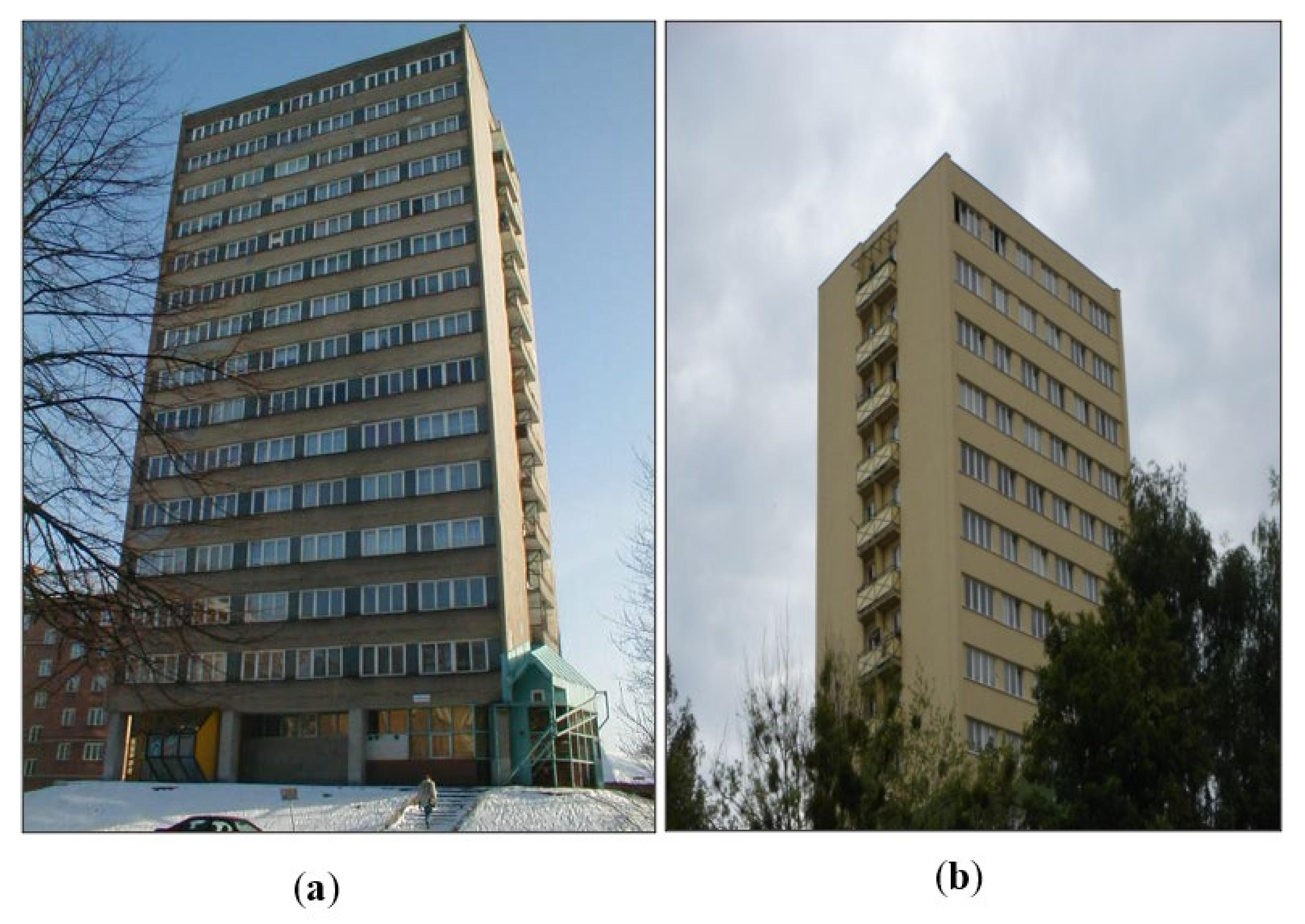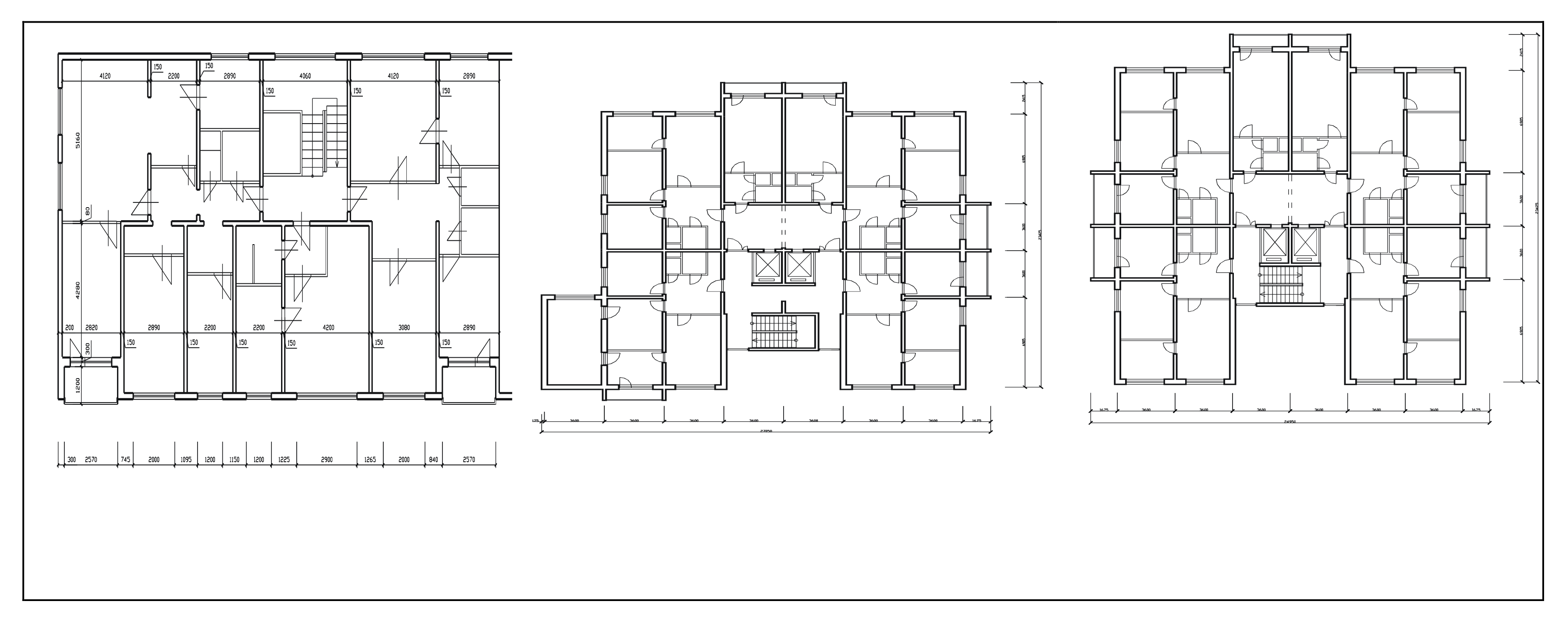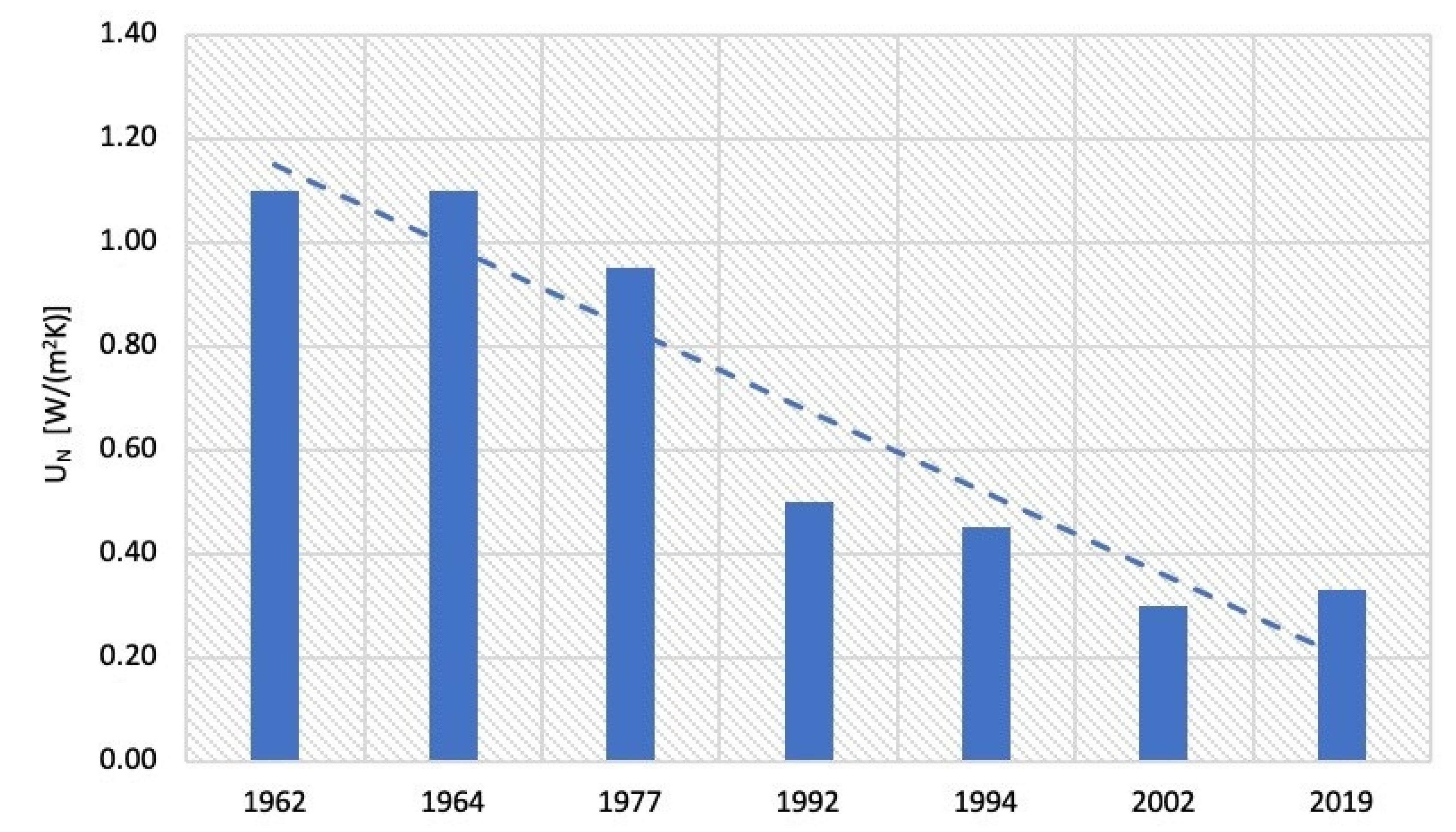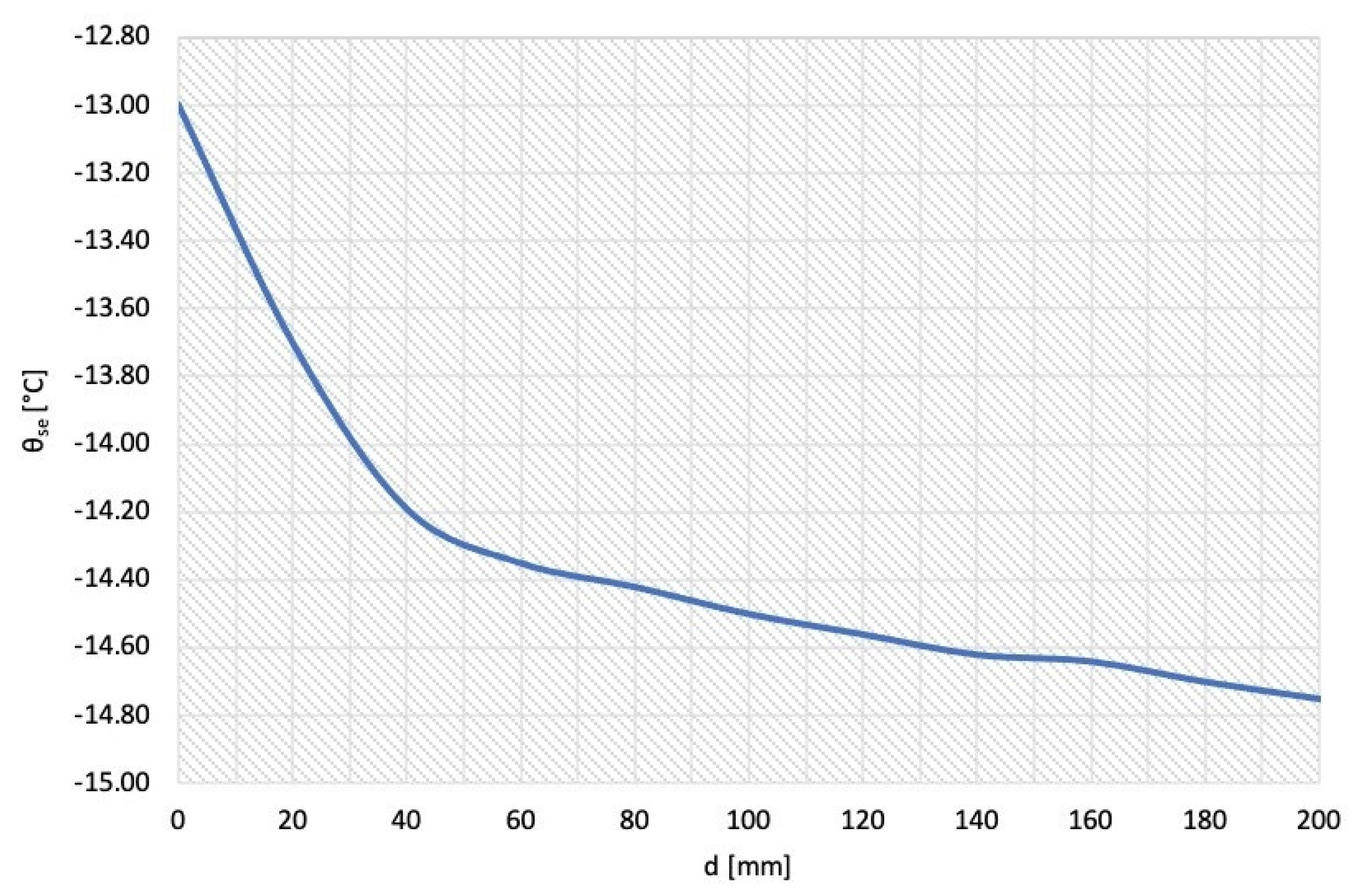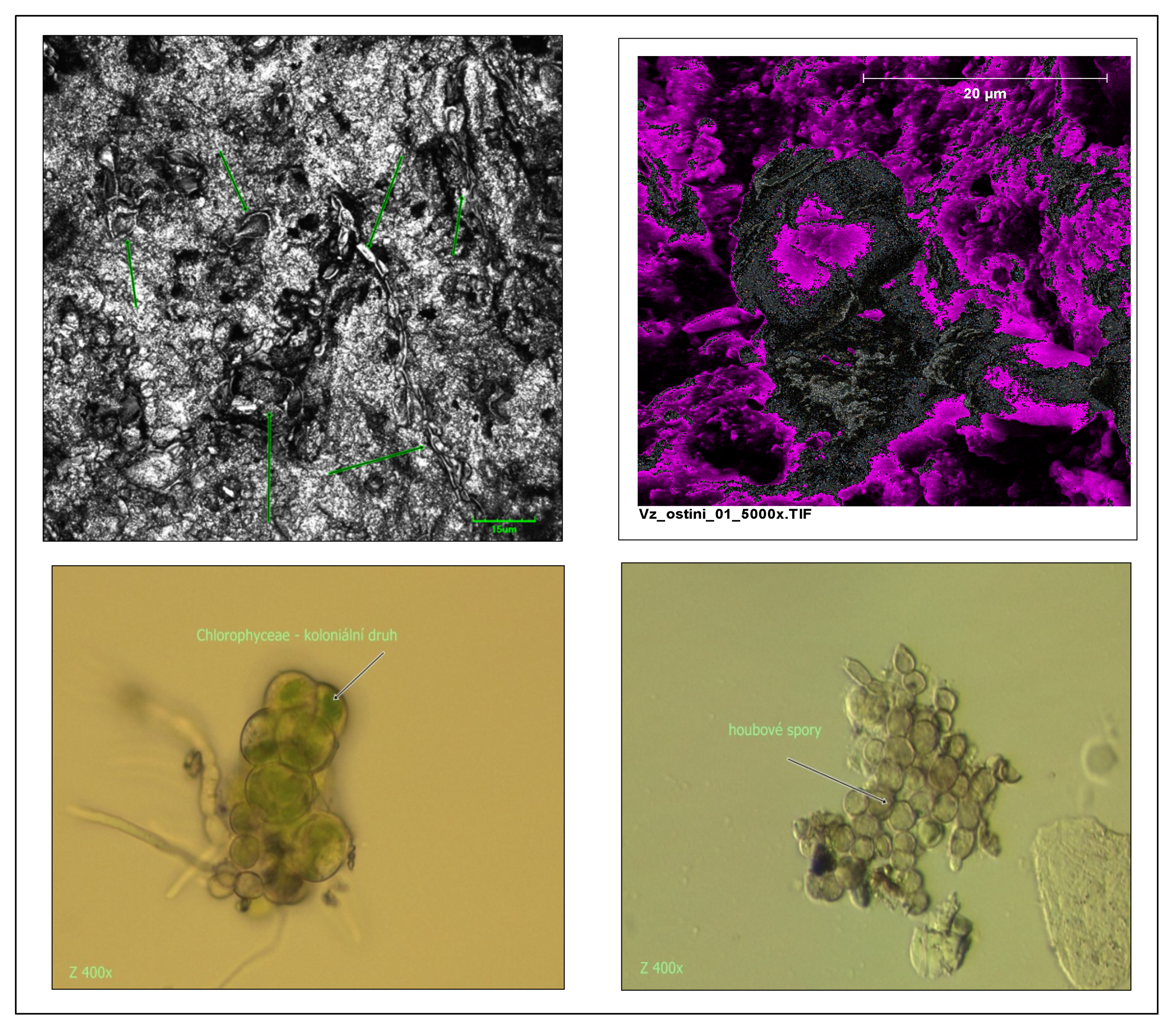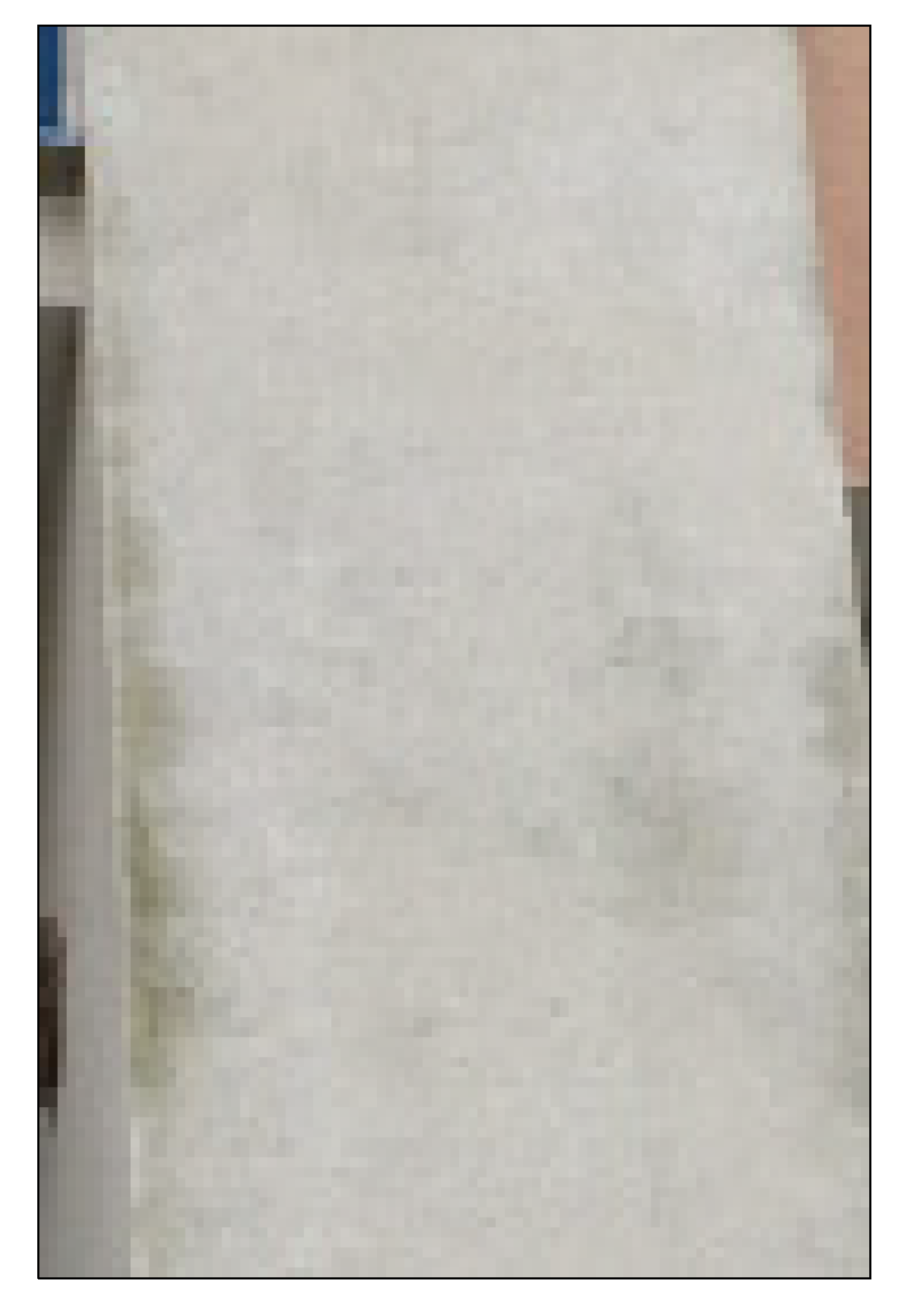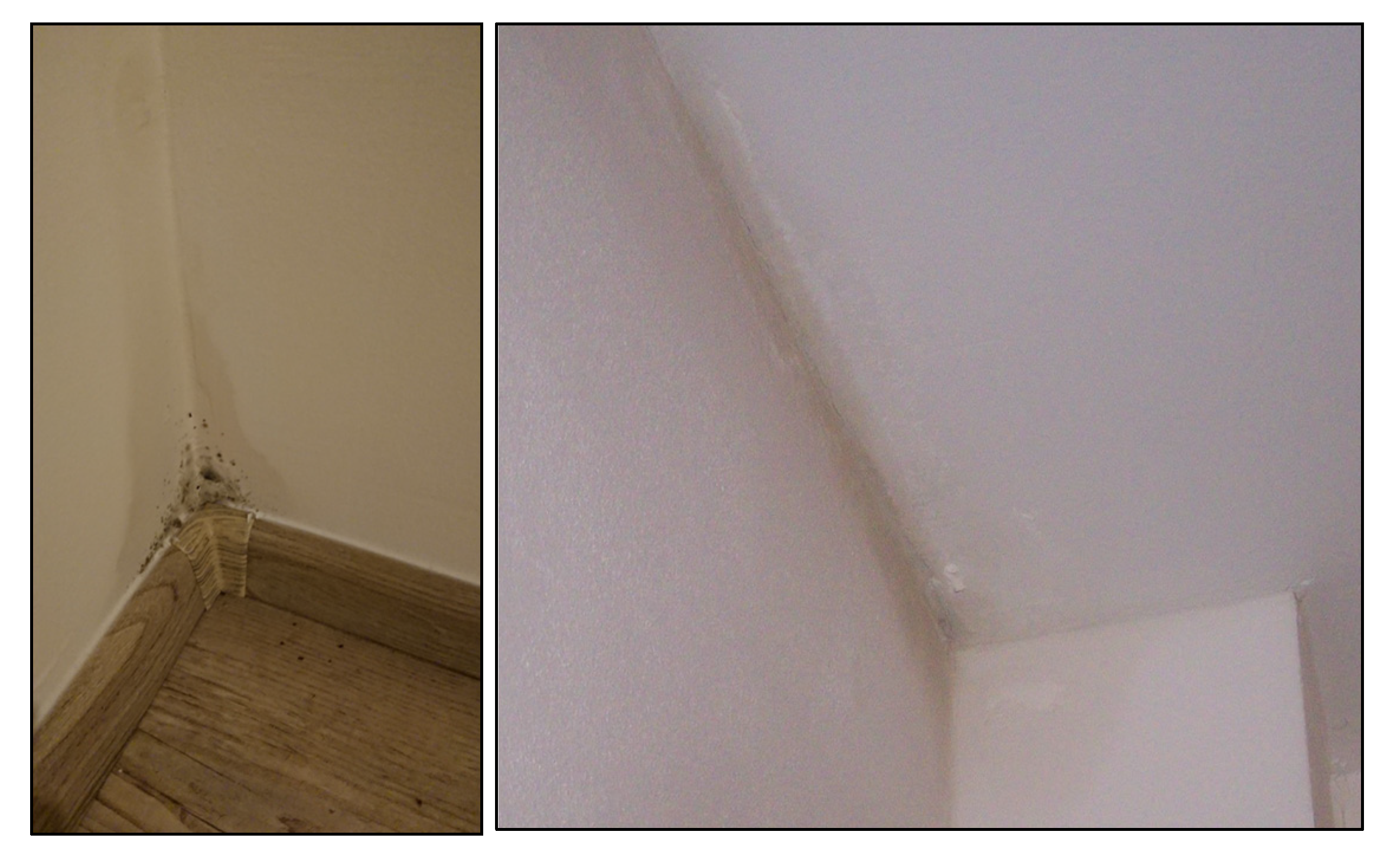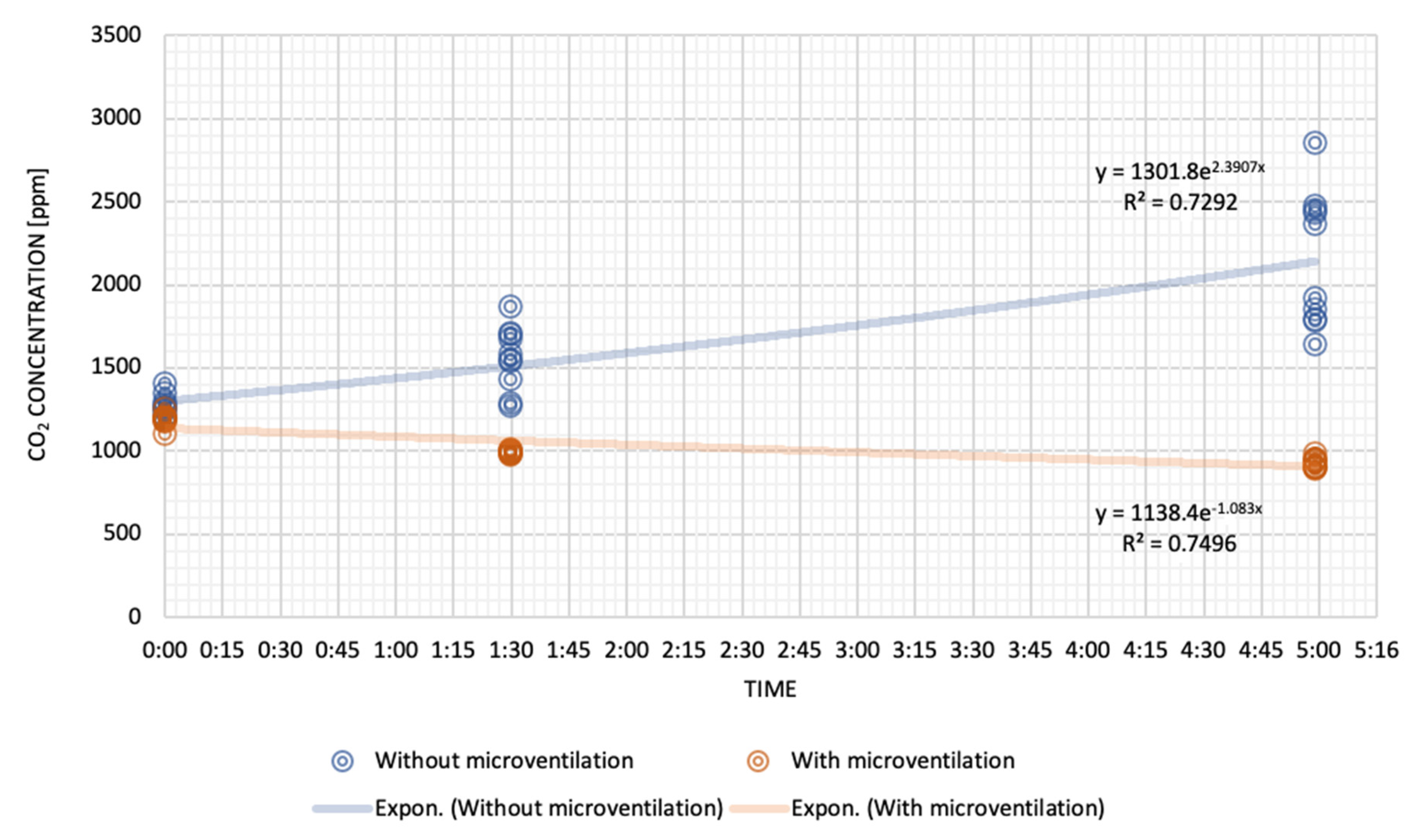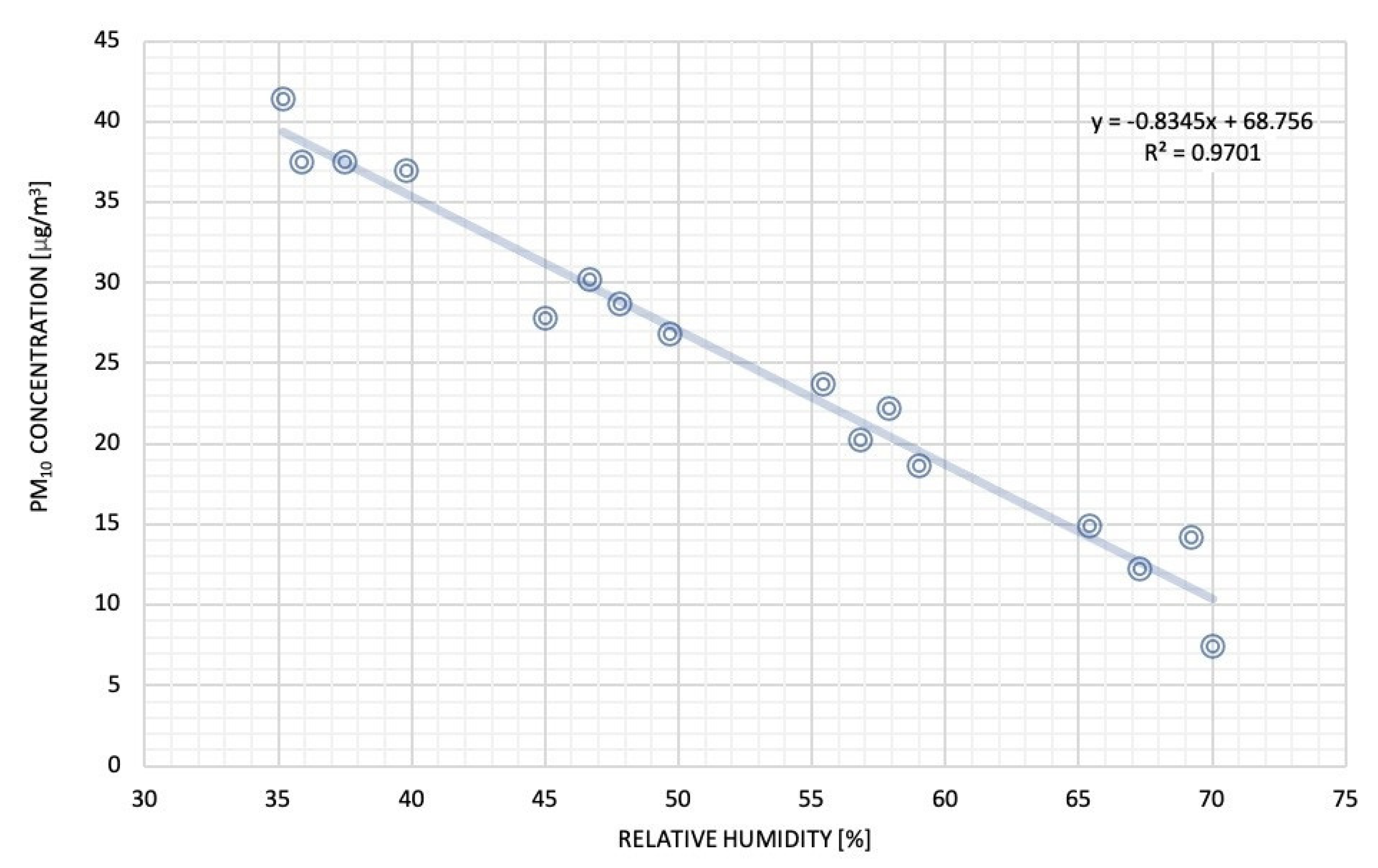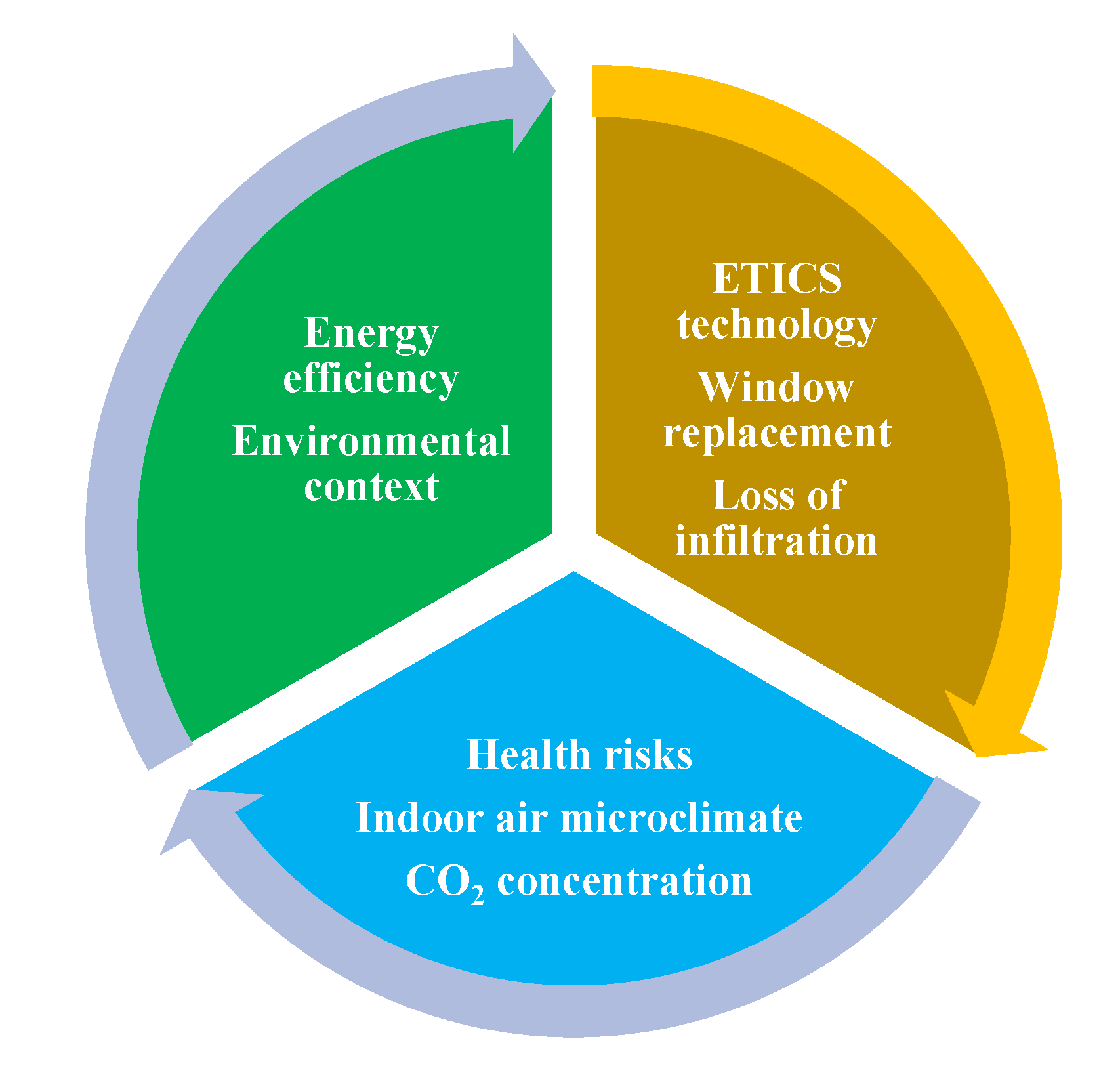1. Introduction
The indoor environment of buildings and indoor air quality (IAQ) is one of the basic criteria for evaluating the quality of a building. According to the U.S. Environmental Protection Agency (EPA, Washington, 2013), indoor air can be up to 5 times more polluted than outdoor air [
1]. The result of the development of building materials, technologies, heating, ventilation, and air conditioning (HVAC), and especially, the energy requirements for buildings, and finally, the behavior of building users, often deteriorates the quality of the buildings’ indoor environment with all the negative consequences for human health and performance. It is known that the microclimate in residential buildings consists of the building material used for building structures, pollutants that penetrate from the exterior into the indoor environment, the layout of housing units, interior equipment, and also the presence of people living indoors. The indoor environment quality (IEQ) is a multidisciplinary scientific area involving a number of factors such as indoor air quality (IAQ), lighting, thermal comfort, acoustics comfort, ergonomics, and many related factors [
2,
3]. Indoor air quality (IAQ) is defined by the presence of pollutants (chemical, biological, or physical) and thermal-humidity conditions in the indoor environment that may negatively affect the health, comfort, and performance of building occupants [
4,
5].
The quality of the interior microclimate of residential buildings is influenced by the trend set after 2010, which consists of the constructing and operation of more energy-efficient buildings, and also—from 1 January 2020 on—constructing new buildings with almost zero-energy consumption. This requirement arises from the implementation of energy law and the EU concept into the legislation of the EU member states [
6]. The nearly zero-energy building standard was primarily set out in Directive 2010/31/EU of the European Parliament and the Council on the energy performance of buildings (recast EPBD II; Energy Performance of Building Directive) [
7], which was updated in May 2018 (2018/844/EU [
8]). The directive defines a nearly zero-energy building as “
a building that has a very high energy performance. The nearly zero or very low amount of energy required should be covered to a very significant extent by energy from renewable sources, including energy from renewable sources produced on-site or nearby”. This requirement applies “adequately” to buildings that are intended for renovation and reconstruction, while no decree or directive further defines what the adequacy of reconstruction and renovation measures is. In general, “proportionality” can be seen in the investment costs of renovation, where reconstruction and renovation should be economical and efficient [
9] and should extend the lifetime of buildings. In common practice, in the renovation of residential buildings, we encounter mainly measures where attention is paid at the same time to reducing heat loss through transmission, improving the value of the thermal transmittance U
N (in W/(m
2K)) of the building envelope, and replacing windows. Perimeter walls of residential buildings are equipped with the contact thermal insulation system ETICS (external thermal insulation composite system) [
10] when the thickness of the insulation—for example, in the case of panel housing construction from the second half of the 20th century (between 1950 and 1985) in former Czechoslovakia—often reaches up to 200 mm according to the valid legislation. Together with replacing windows, the building envelope after the renovation creates a compact unit, which prevents heat leakage on the one hand, but on the other hand, the building loses natural microventilation and air permeability [
11]. In the cases where no recuperation is carried out within the renovation process, or if other construction activities are not carried out, the interior microclimate of residential buildings deteriorates significantly. The countries in Eastern Europe, such as Slovakia, Bulgaria, Hungry, and Serbia, have similar housing stock coming from the Soviet era [
12].
This paper builds on a number of studies on previously performed measurements of carbon dioxide in the interiors of buildings [
13,
14,
15,
16]. Carbon dioxide (CO
2) is one of the biologically active pollutants that originates in occupants’ respiration [
17]. The combustion of solid fuels is also a source of carbon dioxide and water vapor. With the increasing concentration of carbon dioxide, the amount of water vapor in the air and thus the relative humidity of the air increases as well. The number of people present in a room, their activities, the size of the room, and insufficient ventilation are the main reasons for the increase in the concentration of carbon dioxide. With increasing airtightness, the problem of increasing CO
2 concentration becomes more serious. The study in [
18] analyzed the relationship between CO
2 concentration, user health, and sick building syndrome. Sick building syndrome (SBS) can be defined as a group of relatively serious illnesses and health problems that people may have because of living in closed rooms for a long time (see
Appendix A for the problems caused by the syndrome), [
19,
20]. Human physiology and its activity in the indoor environment of buildings are among the dominant components that worsen the quality of the indoor environment, increasing CO
2 concentration. It is thus clear that all the laws of the building’s environmental system must be respected in the renovation design.
1.1. Development of Standard Requirements and Environmental Aspects
Thermal engineering and energy are an integral part of the architectural and structural design and operation of new or renovated buildings. The development of standard requirements in the Czech Republic has changed significantly since 1960 (
Figure 1). Stricter requirements have naturally led to the need to improve the condition of the perimeter walls of panel construction, and the application of the ETICS composite has been a very good technology that meets the set standard requirements in terms of appropriate thickness. However, with the increasing thickness of the ETICS composite, we are increasingly encountering the phenomenon of biodegradation of the facade. It is clear from the well-known building-physical contexts that less heat escapes from renovated apartment buildings through the composite perimeter wall, but less heat escapes through the outer surface of the façade, and the surface becomes colder (
Figure 2). Cold surfaces create condensation over a longer period time. This creates a favorable microclimate for the growth of lichens, mosses, and algae because all microorganisms need moisture for their life [
11,
21]. Condensation in structural plaster structure creates a favorable microclimate for the settlement and growth of microorganisms, which subsequently spread over the entire area or locally. (
Figure 3). The biological factors/elements acting on the perimeter cladding of buildings in the form of algae, fungi, and lichens thus negatively affect the aesthetic appearance perception of the building as a whole (
Figure 4).
Figure 2 shows the relationship between thermal insulation thickness and facade surface temperature under standard model conditions θ
e = −15 °C, θ
i = 21 °C. The facade surface temperature before the application of additional thermal insulation is θ
se(0) = −13.0 °C. After the application of thermal insulation with a thickness of only 20 mm, there is a significant drop in the temperature by 0.7 °C. After applying ETICS insulation with a thickness of 200 mm, the temperature decreases to θ
se(200) = −14.7 °C, which is a difference of 1.7 °C [
22].
Thus, the growing problem with green facades (
Figure 3) is due to the combination of natural influences, poor quality materials, insufficient thickness of thermal insulation (see
Appendix B for ETICS thickness issues), and nonprofessional implementation.
1.2. Effects of the Revitalization of the Building Envelope on Indoor Environment Quality
Increasing energy prices and the threat of resource depletion have led to savings, especially in heating sources. This situation was reflected significantly in the Czech Republic after the economic and political changes that occurred in 1989, and its influence continues escalating. A frequently observed and proven problem of these revitalized prefabricated houses is the sealing of natural ventilation slots and the replacement of original windows with new and very tight windows. Due to insufficient ventilation, there is a risk of harmful substances and the deterioration of the quality of the indoor environment. Common pollutants in building interiors include water vapor, carbon dioxide, carbon monoxide, nitrogen oxides, and volatile organic compounds (VOCs) [
24,
25,
26,
27] (see
Appendix C for more on VOCs). In general, the tighter the building envelope, the higher the concentrations of pollutants measured.
The concentration of carbon dioxide in the interior is a good indicator of the degree of pollution in the indoor environment. CO2 concentration is expressed in ppm (1 ppm = 0.0001% by volume). The concentration of CO2 in the outdoor environment in the Czech Republic is about 400 ppm (the value can be even higher in urban areas, e.g., in Prague, the values are 430–470 ppm). The metabolic production of CO2 is defined as a function of a person’s height, weight, and physical activity. According to this function, the production is about 4–26 L of CO2 per hour.
At the time of the construction of such apartment buildings and houses, no demands were placed on windows and doors (unlike today), and fresh air permanently penetrated the interior through window joints and leaks around the windows. In this natural way, a sufficient supply of fresh air to the interior was ensured. This method of ventilation, along with adequate ventilation of the windows, is called natural ventilation. Natural ventilation requires a certain degree of self-discipline and system from building occupants. If a building is not sufficiently ventilated, the humidity in the apartment increases, and mold is formed (
Figure 5) [
28,
29,
30,
31,
32].
The issue of prefabricated buildings is still relevant after 2010. The implementation of legislative regulations plays an important role in the field of energy-saving and heat protection into the legal frame of the Czech Republic. This applies in particular to the implementation of the European Directive EPBD II (Energy Performance of Building Directive II.). The implementation of the directive into the legislation of the Czech Republic is a process that leads to an increase in the quality of buildings, including prefabricated residential buildings, and the improvement of their technical equipment. The European Union’s objectives therefore include not only reducing the energy consumption of buildings as a contribution to the quality of the environment, but also reducing air pollutants in the process of energy production for heating (especially CO2) and promoting renewable energy sources. High-quality remediation interventions in the application of additional contact insulation with ETICS could reduce heat loss in buildings built with panel technology in the field of thermal engineering and energy. In connection with the current state of panel housing construction, faults and defects of the ETICS can be monitored after the building envelope has been insulated. These defects occur to a fair extent in all basic and modified systems. The evaluation of prefabricated apartment buildings has been carried out continuously by the authors since 2000. As mentioned, the monitoring in the first phase focused on the issue of defects and failures of perimeter cladding related to thermal engineering and energy performance. After 2010, the defects and failures in the area of biodegradation of perimeter cladding with ETICS and the deterioration of the quality of the indoor microclimate were observed. Monitoring was performed in connection with the quality of the indoor environment, in particular high CO2 concentrations, unless a forced ventilation regime is provided. The monitoring of prefabricated houses takes place in the Ostrava-Karviná region, in the cities of Ostrava and Havířov (Czech Republic).
The unifying goal of the research work is to use a representative example that is based on the long-term monitoring of panel residential buildings to show both the need for the interaction of environmental issues and the behavior of building structures in the design and operation of reconstructed buildings. Ensuring a lower energy intensity of panel residential buildings, on the one hand, ensures an economically competitive construction, but on the other hand, it brings a number of specific problems which, without taking into account all contexts, can lead to sick building syndrome and thus contribute to a deteriorating quality of life in residential buildings. The task of reconstruction work of panel residential buildings is not only compliant with legislative and standard requirements in the field of energy consumption but also with a new dimension of construction activities related to construction, architectural, environmental, sociological, and economic requirements.
In the context of the monitored issues, the research question is directed towards whether in the fulfillment of the current energy requirements, the quality of the building envelope exterior in the entire life cycle of the buildings compares with the indoor air quality of prefabricated apartment buildings. The aim of the paper is to demonstrate the deterioration of indoor air quality caused by the revitalization of the building envelope that leads to a reduction in energy consumption in accordance with the requirements of the European Union. Concentrations of carbon dioxide, dust particles, and volatile organic compounds are monitored in typical flats of panel prefabricated buildings.
2. Materials and Methods
The interior microclimate of residential buildings and environmental contexts can be documented on an example of an apartment building that was built in the 1970s. The apartment building is heated by a central source of district heating and there is natural ventilation. Ventilation is conducted only in hygiene rooms (bathroom and toilet). The perimeter cladding based on gas silicate was provided with ETICS in the thickness of 80 mm. In efforts to update the building, the wooden windows were replaced by new plastic windows with double glazing insulation. The roof cladding was also renovated. The insulation thickness of 80 mm was sufficient for the time when the renovation was carried out, that is, in 2005, and in terms of the requirements at that time, the thickness was satisfactory.
The monitored prefabricated buildings are a part of the construction technical survey (TS) that has been carried out by a team of authors since 2000. This monitoring and evaluation has been ongoing until now. Panel residential buildings located in Ostrava and Havířov were evaluated (an overview of the monitored houses is given in
Appendix D,
Table A2,
Table A3 and
Table A4). In the first phase of the TS, the condition of the original perimeter cladding was evaluated in terms of thermal properties and then after insulation with ETICS. After 2010, the TS focused on the issue of the biodegradation of ETICS (as a new failure of perimeter cladding) and on the deterioration of the quality of the internal microclimate, after the insulation with ETICS (
Appendix D,
Figure A1). An example of a case study is representative of this, based on the typological principles of prefabricated residential buildings. This corresponds to the cubature of the bedroom (
Appendix D,
Figure A2), which can also be adequately related to other monitored structural systems.
Measurements in terms of CO2 concentration were performed during the heating season for ten nights. The meters for measuring air quality parameters were placed in the apartment unit bedroom (40 m3), where a CO2 transmitter was placed. The transmitter recorded data at regular five-minute intervals, and the times 00:00, 01:30, and 05:00 were selected to determine the degree of CO2 concentration while simulating variant conditions of bedroom occupancy and ventilation mode.
The monitored physical quantities included indoor air temperature (°C) and indoor relative humidity (RH in %) with the simultaneous monitoring of CO2 concentration (ppm), PM10 particulate matter concentration (µg/m3), and outdoor air temperature (°C). The physical condition of the users was defined by weight (kg) and height (cm). Variant conditions of bedroom occupancy and method of ventilation and heating are as follows:
1 person, weight: 77 kg, height: 175 cm, window microventilation closed;
1 person, weight: 77 kg, height: 175 cm, window microventilation open;
2 persons, weight: 77 kg, height: 175 cm, weight: 110 kg, height: 180 cm, microventilation closed;
2 persons, weight: 77 kg, height: 175 cm, weight: 110 kg, height: 180 cm, microventilation open.
In the second part of the experiment, attention was paid to dust particles. The concentrations of indoor particles are strongly influenced by climate conditions. On the basis of our previous experimental measurements, it was found that physical factors of the indoor environment (temperature, moisture, air change, air movement, particles deposition, static electricity, and indoor light ions) and the performance of building structures (roughness and porosity of the building material surfaces, and the volume of the room) have a determining influence on the appearance of particulate matter. The measurements were provided for a thoracic fraction of particulate matter expressed as PM10 mass concentration. The mass concentration was obtained after the continuous sampling and following laboratory assessments.
The indoor particles observation was estimated according to the methodology of measuring for a PM10 fraction of suspended particulate matter (CSN EN ISO 16000-1: 2007 Indoor air—Part 1: General aspects of sampling strategy). The indoor monitoring of particulate matter PM10 was carried out with a volumetric particle and pollen sampler, the VPPS 2000 Lanzioni (developed by Lanzioni Spa, Bologna, Italy), with an air flow from 5 to 12 L per minute, located at the center of the monitored room in height 105 cm above the floor (breathing zone for sitting person). The sampling of the indoor air was performed continuously over a 24 h period at an air flow of 600 L per hour. Inorganic analytes were collected on a nitrocellulose membrane filter, Synpor (Pragochem, Czech Republic), with a diameter of 35 mm and a pore size of 0.83 µm. Before sampling, the nitrocellulose membrane filters were kept under constant air temperature and at 50% relative humidity in desiccators for at least 24 h in the laboratory chamber. Then, the filters were weighed. After sampling, the filters were kept under the same conditions for 24 h in other desiccators, and the weight of the filter was measured again. The particular mass concentration was determined by the gravimetric method on the basis of the filter weight increase (with a tolerance of ±0.00001 g).
The concentration of total volatile organic compounds (TVOC) expressed as the concentration of toluene was measured with ppbRAE 3000, which is a photoionization detector (PID) with a UV lamp. This device has a measuring range of 1 ppb (parts per billion) to 10,000 ppm and a measurement accuracy ±3%. A three-second response time allows for real-time monitoring with this instrument. Concerning energy savings, the case study shows that the relationship between the indoor air quality and the quality of the residents’ life in prefabricated apartment buildings is conditioned by the quality of work performed in relation to the thickness of the ETICS. It is necessary to take into account all other aspects such as the quality of windows with controlled microventilation, the ensuring of controlled ventilation, etc.
3. Results
The measured values according to the set environment simulations are given in
Table 1.
Table 2 takes into account the parameters of the external environment.
The results of experimental measurements on indoor air quality and simulations of room occupancy and ventilation and the interior heating regime in winter indicate the following:
A higher concentration of CO2 using a bedroom at night (from 0:00 to 5:00) when occupied by 2 people of an average weight of 93.5 kg and an average height of 177.5 cm, when the microventilation of the window is closed and the temperature in the interior is set to 21.0 °C, show that the condition can be considered hygienically unsuitable from 01:30 until the morning hours; the CO2 concentration exceeding above 1500 ppm already occurs at 01:30, and at 05:00 the CO2 concentration exceeds 2000 ppm.
An acceptable condition that is not hygienically harmful is the condition when the room is occupied by one person weighing 77 kg at 175 cm high, when the window microventilation is closed or open, and the interior temperature is set to 21.0 °C.
From the measured values it is evident that with the microventilation of the window opened, it is not possible to ensure a constant indoor temperature ti = 21 °C at night when the heating head is set to ti = 21°C; the temperature ti = 21 °C can be ensured by setting the heating head to ti = 23–24 °C, at which point the CO2 concentration can then be considered adequate but at the expense of heat leakage.
The CO2 concentration exceeds the limits of 1500 (ppm) from 05:00 when the bedroom is occupied by 1 person weighing 77 kg. When the bedroom is occupied by 2 people weighing 77 and 110 kg, the CO2 concentration exceeding 1500 ppm occurs already at 01:30 am, and at 05:00 the CO2 concentration exceeds 2000 ppm.
Figure 6 illustrates the CO
2 concentration (ppm) depending on the type of ventilation.
Exponential trends reflect the level of CO2 concentration for open and closed microventilation. Microventilation (sometimes referred to as slotted ventilation) is the unsealing of the window, balcony, or terrace door based on creating a gap between the sash and the frame. The width of the gap is between 3 and 6 mm. The trends show that microventilation has a positive impact on the quality of the indoor environment in terms of CO2 concentration. However, microventilation presents a number of problems. Due to insufficient air exchange by joint ventilation (microventilation), windows are no longer standardly equipped with joints. Joint ventilation does not provide the necessary air exchange in the summer months, in that there are no temperature and pressure differences. In the winter months, its use is even inappropriate. Warm air from the room when using microventilation will condense in the functional joint and may cause damage to the window structure.
The CO
2 concentration of 1500 ppm can be considered as a limit value in terms of negative impact on human health, and the CO
2 concentration exceeding 2000 ppm is harmful to human health. This concentration creates a hygienically harmful environment in terms of the interior microclimate. From the measured data during an eight-hour sleep in a bedroom of 40 m
3, it can be seen that two people in the night sleep mode stay approximately for 50% of the time in a hygienically defective interior microclimate (
Table 3).
The indoor particle concentration measurements in relation to relative air humidity were performed in the range of 35–70% for the global air temperature between 22 and 24 °C (mean value of global air temperature being at 23.2 °C). A linear dependence between the indoor particles concentrations and the relative air humidity is shown in
Figure 7.
From the measured results of the particles concentrations, the following can be seen: A PM10 concentration mean value of 38.8 µg/m3 was achieved by a relative air humidity mean value of 37.8%; a PM10 concentration mean value of 29.7 µg/m3 was achieved by a relative air humidity mean value of 47.6%; a PM10 concentration of 22.2 µg/m3 was achieved by a relative air humidity mean value of 56.9%; and a PM10 concentration mean value of 11.1 µg/m3 was achieved by a relative air humidity mean value of 67.8%.
From the results, the decreasing trend of the values for PM10 concentration is evident. The highest value for PM10 concentration (42.3 µg/m3) was achieved by a value of 35.8% for relative air humidity and the lowest (7.4 µg/m3) by a value of 70.1% for relative humidity. The difference between the highest and the lowest concentration values was 34.9 μg/m3. The decrease of relative humidity by about 10% expects a 10 µg/m3 PM10 concentration decrease in the case of the abovementioned determined conditions. The results of the experimental measurements show that the hydrothermal microclimate of the indoor environment has a significant impact on the concentration of dust particles. The lower the relative humidity of the indoor air, the higher the PM10 concentration is. The correlation can be expressed by a linear equation (y = −0.8345x + 68.756) with a reliability coefficient of 97.01%.
A total volatile organic compound concentration limit of <120 ppb was set as a healthy environment reference and a threshold over 1200 ppb for risk environment. These considerations are a general rule, but they are very variable depending on the type of VOC compound present in the air. The indoor average TVOC concentration was below the 1200 ppb threshold with varied distribution. The 95th percentile values were 678 ppb (A) and 429 ppb (B) with no regular behavior patterns. The indoor concentrations are higher in winter than in summer because of the fact that more frequent ventilation contributes to greater dilution (
Table 4).
4. Discussion
With the standard technological procedures of thermal insulation in prefabricated residential buildings (i.e., with the application of the ETICS contact thermal insulation system and window replacement) implemented in the second half of the 20th century in order to improve the thermal and energy parameters in the winter, the relative humidity of the interior increases, and the CO
2 concentration often rises above the values of 2500 ppm. Microventilation in the night sleep mode at an interior temperature of 21 °C does not ensure air exchange for two people in bedrooms with a volume of 40 m
3; on the contrary, it cools down the interior. In areas where there is a higher concentration of airborne dust, there may be situations in which spores diffuse into the indoor environment, either from the air or the biodegraded facades of apartment buildings. Thus, paradoxically, the remediation measures of apartment buildings can contribute to the hygienic defects of the rooms and create an interaction of connections that need to be kept in mind when carrying out remediation measures (
Figure 8).
Renovation design of prefabricated residential buildings at the stage of project documentation should take into account all contexts that are related to the improvement of the thermal, technical, and energy parameters of residential buildings. Taking into account the aspect of user comfort is in the interest of users. Owners of refurbished houses should be made aware of the fact that without further technical measures (such as recuperation), they may be exposed to CO2 concentrations ranging from borderline to above the limit, especially in winter.
According to the WHO, volatile organic compounds in the form of pollutants, including CO
2, which occur in the indoor environment of buildings, cause sick building syndrome (SBS). For example, the WHO report in 1984 showed that in the United States and European countries, over 30% of the population suffers from sick building syndrome. In the 2002 report, the WHO already noted a higher number of people with disabilities, i.e., up to 60%; after 2014, the value rose to 85% [
34].
Around 1,165,000 housing units have been built in the Czech Republic since 1955, mainly using panel construction [
35]. The process of panel housing construction was not stopped in former Czechoslovakia. This was due to the time that the then socialist state was going through. In postwar Czechoslovakia decimated by World War II, apartments and the related infrastructure needed to be built quickly. At that time, in terms of the speed of construction, panel construction was the most suitable one. The prefabrication of building components developed intensively in former Czechoslovakia since 1948. The trend in the production of prefabricated components was set at more than 4,600,000 m
3 since 1970; after 1980, prefabrication was used in 91% of buildings for housing and civic amenities in the city (
Appendix D,
Table A1). After that, there was a gradual decline, and the end of the massive production of prefabrication was recorded in 1989 when the Velvet Revolution took place [
35]. The construction of such buildings is closely related to a high share of CO
2 generation in the form of embodied emissions. The reason for this is a high consumption of concrete, which is highly energy intensive [
36]. The current construction industry aims to reduce the consumption of high energy-intensive materials to a minimum and to expand the share of renewable and recycled materials. Appropriate materials and technologies can significantly reduce the environmental and energy impact of building operation and maintenance of the environment. In addition to reducing carbon dioxide emissions, a reduction of operating costs can also be achieved [
37].
The rehabilitation of prefabricated apartment buildings from the second half of the 20th century must be understood as positive and necessary because this leads to the extension of the lifetime of prefabricated residential buildings by another 30 years at least. If, in the second half of the 20th century, prefabricated apartment buildings were expected to last 50 years, then it follows that after 2010, the demolition of these houses will have to begin. The idea that the housing estate will be demolished is completely unrealistic, whether from a sociological or economic point of view. The standardized housing construction in former Czechoslovakia has led to the utilization of entire housing estates [
35]. The fact is that from the point of view of the Czech Republic, the current housing estates are considered as marginalized; on the contrary, housing estates are home for many inhabitants.
5. Conclusions
The current situation shows that the trend in the field of civil engineering and architecture set after 2000 is mainly aimed at prioritizing the energy efficiency of buildings. The indoor air quality and comfort of users is one of the fundamental pillars of sustainable construction. This set trend with regard to the quality of the interior microclimate of buildings is taken into account especially in the case of new constructions; when designing a building, we respect all constructional, physical, architectural, and structural contexts, including the environmental context, and the building is assessed comprehensively.
In the case of residential buildings that were built in the second half of the 20th century, especially using panel construction, measures in the form of ETICS application lead to a more energy-efficient condition in accordance with the applicable legislation. Without taking into account the connection with the ventilation regime and other environmental contexts, however, these measures create a qualitatively worse interior microclimate and a hygienically harmful indoor environment. Users and owners of residential buildings prefer investments only in insulation. The issue of ventilation is rather marginalized. It is, therefore, necessary to re-evaluate this situation and set measures that allow the renovations to be conceived comprehensively, and the energy efficiency of the building can be carried out in connection with ventilation to ensure the supply of a sufficient amount of fresh air. User instructions that were given as “the user ensures proper ventilation of the apartment” are insufficient and will not solve the problem of ventilation.
Panel residential buildings realized in the second half of the last century in the Ostrava-Karviná region and the whole Czech Republic cannot be considered as a specific and unique phenomenon of the Czech Republic. The trend of this type of construction was reflected in all European countries. Prefabricated residential buildings realized in the second half of the last century were evaluated negatively after 1989, mainly due to the monotony of prefabricated construction, which was caused by volume and the elemental utilization of entire buildings and practically entire prefabricated housing estates. These points are elaborated in the following:
European countries had to deal with similar housing problems, especially after 2nd World War. The identical and different features of the housing policy of European countries, including their dynamics, are evident from a historical point of view: the development of housing policy in many European countries after 1945 shows that in the early 1970s, during the ‘golden era’ of housing policy, which had to solve absolutely fundamental problems, namely the elimination of post-war housing shortages, the renewal of housing stock, including raising housing standards, and at the same time act as a tool to stimulate economic development. After this period, the end of which is not completely uniform in European countries, i.e. since the 1970s, there is a more significant differentiation of individual countries’ approach to housing; countries began to place more emphasis on their traditions and economic possibilities and began to address partial problems concerning only a part of the population, a certain segment of the housing market, etc., which have their own specific features in each country; the reduction of the role of the state and the strengthening of market principles, which requires greater consideration of the specific local situation, also contributed to greater differentiation between the housing policies of individual countries [
38].
It is clear from the integration process of the member states of the European Union that the influences of the European Union on the sphere of housing are constantly increasing. These include strengthening the influences, among others, in the rules for awarding public contracts in housing construction, ensuring the impact of investment activities on the environment, strengthening the influence in the field of regulation of construction products and materials, housing financing, property relations, the unification of processes on housing policy, application of the principles of sustainable construction, etc. The implementation of legislative regulations in the field of energy-saving and heat protection into the legal conditions of the member states plays a major role in the area of housing construction.
Within the European Commission, a number of organizations and associations deal with the issue of housing. It is, for example, the European Network for Housing Research (ENHR) that has a number of commissions related to this issue, such as the Commission for Rehabilitation, Modernization and Maintenance of Housing, the Commission for Social Housing, the Commission for Urban Planning, and others. In Europe, the organization CECODHAS (The European Liaison Committee for Social Housing) also focuses on the issue of housing in Europe, and the organization includes the solution of energy issues. Other expert working groups include, for example, the HAS (Housing Studies Association) and the EURA (European Urban Research Association); the issues of housing, energy, and microclimate are addressed at a number of university workplaces, such as TU Delft, Technical University of Vienna, and others.
It is clear from the results of the activities and work of expert commissions that the integration character in housing policy within the member states of the European Union has a long-term character, especially due to the diversity of member states’ housing policies, different concepts of rental housing, social, economic level of member states, etc.
The views and currents of opinion on panel housing construction will be different. In the developed economies of the EU member states, housing construction in panel technologies is intended more for socially weaker groups or is related to migration policy, whereas in postcommunist countries, it is a type of construction that will continue to have a place for thousands of people, and these houses will be home to them. Therefore, all remediation interventions should be effective and high quality, and they should not lead to new defects and failures.
This study should therefore be considered representative. The results can be related to the panel residential construction that was carried out in all postcommunist countries and in which there are similar remediation interventions taking place, as in the Czech Republic. It can be predicted that remediation interventions after the application of ETICS will eliminate the thermal technical deficiencies of the building envelope and improve the energy concept, but on the other hand, they can bring modern failures in the form of biodegradation of facades and the deterioration of indoor air quality.
